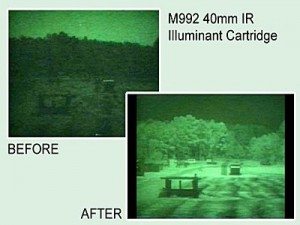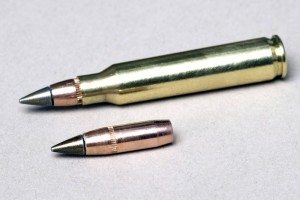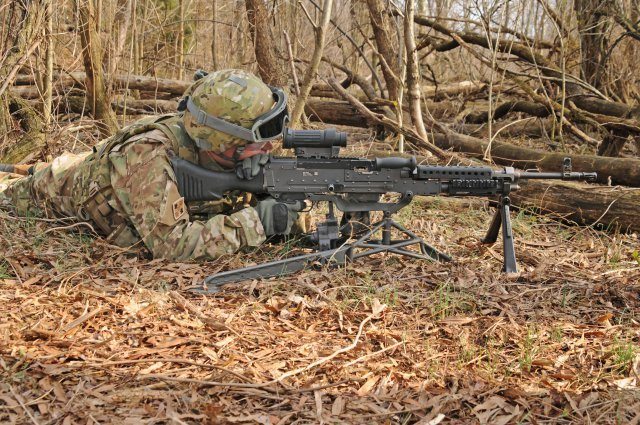Army officials announced the winners of its greatest inventions competition Aug. 23. Earlier this summer a panel of combat veteran Soldiers reviewed and voted for the most innovative advances in Army technology.
“The contributions made by these teams promise to improve the well being of Soldiers and the Army’s capability to contribute to quality of life and our national security,” said Maj. Gen. Nick Justice, U.S. Army Research, Development and Engineering Command commanding general. “I would like to expressly thank you for submitting your Army Greatest Inventions nomination packages which continue to make the Army Greatest Inventions program a success.”
The winners, in alphabetical order:

40mm Infrared Illuminant Cartridge, M992: Soldiers now have capabilities to engage the enemy far more effectively during nighttime operations. The Army’s new infrared illuminating cartridges/projectiles produce infrared light that is invisible to the naked eye, but is clearly visible through night vision devices that U.S. Soldiers use in Iraq and Afghanistan. (Source: Armament Research, Development and Engineering Center)
5.56mm M855A1 Enhanced Performance Round: Since June, the Program Executive Office for Ammunition at Picatinny Arsenal has fielded about 30 million new 5.56mm M855A1 Enhanced Performance Rounds in Afghanistan. The bullet has been redesigned and now features a larger steel penetrator on its tip. A notable feature of the EPR is that its bullet features a copper core. (Source: Armament Research, Development and Engineering Center)
Green Eyes – Escalation of Force Kit Integration with the CROWS System: The system emits a wide band of green light that temporarily disrupts a person’s vision so that driving a vehicle or aiming a weapon becomes difficult if not impossible. One application would be to warn civilians away from checkpoints and other areas where their safety is at risk. At closer distances, the lasers provide an immediate, non-lethal capability to deter aggressive actions. (Source: Armament Research, Development and Engineering Center)
Husky Mark III, 2G 2-Seat Prototype: This landmine detection vehicle is blast survivable, overpass capable and field reparable. Officials said the second generation 2-seat prototype is a natural evolution of the larger MK III Husky. The Husky Mark III/2G 2-Seat Prototype responds to the immediate warfighter need to mitigate the risks of task overload on the Husky operator, increases the Route Clearance Package’s ability to find and neutralize improvised explosive devices, or IEDs, and provides direct fire capability for the lead vehicle of the RCP.
The kit allows for the platform to be transported with air assets in a roll-on-roll-off configuration, increasing the readiness level and, at the same time, decreasing the logistical footprint and costs of maintaining the equipment in the theater of operations. (Source: Aviation and Missile Research, Development and Engineering Center)
Jackal Explosive Hazard Pre-Detonation System: The Jackal is an IED defeat system designed to remove the threat of IEDs against Soldiers, tactical vehicle platforms and overall mission success. In 2010, the Armament Research, Development and Engineering Center developed and fielded Jackal to Soldiers throughout Iraq to help counter roadside bombs. In particular, Jackal neutralizes the lethal IED threats putting Soldiers at risk during route clearance and convoy related missions.
Jackal functions to keep Soldiers outside the IEDs area of lethality and increase the survivability of vehicle platforms. Unlike its predecessors, the Jackal is designed to be modular and adaptable to new and emerging IED devices. Therefore, the Jackal provides significant capability to the Soldier and their mission and, more importantly, saves lives. (Source: Armament Research, Development and Engineering Center)
M240L 7.62mm Lightweight Medium Machine Gun: The new machine gun reduces the weight of the existing M240B without compromising reliability. “The titanium M240L represents a leap in weapons technology inspired by Soldier feedback. The lessons learned from this program will undoubtedly benefit future weapons systems that will maintain our continued advantage on the battlefield,” said Col. Douglas Tamilio, Project Manager Soldier Weapons for PEO Soldier. (Source: Armament Research, Development and Engineering Center)
mCare Project: mCare, short for mobile care, is a cell phone based bi-directional messaging system developed by the U.S. Army Medical Research and Materiel Command’s Telemedicine and Advanced Technology Research Center. mCare was developed by modifying commercial off-the-shelf technologies to meet the unique needs of the Army Medical Department. Secure, HIPAA-compliant messaging system was needed to operate on wounded warriors’ existing mobile devices, in a manner uniquely distinct from text messaging or email.
This allows members of the care team to connect with Warriors-in-Transition throughout their outpatient recovery process through a device they already own and are familiar using — their personal cell phone. (Source: U.S. Army Medical Research and Materiel Command)
Mortar Fire Control System – Dismounted: The MFCS-D reduces time to fire first round from eight minutes during the day and 12 minutes at night to less than two minutes for both day and night. The kit consists of ruggedized computers, battery power supplies, displays, navigation and pointing hardware, and associated mounting hardware.
The system enhances the responsiveness of the M120A1 120mm Towed Mortar System, enabling digital coordination of multiple systems and fire support network and significantly reducing time required to emplace, fire and displace the weapon. (Source: Armament Research, Development and Engineering Center)
RG-31 Robot Deployment System: The need for a low-cost and lightweight solution in transporting and deploying route clearance robots in combat brought on the development of the TARDEC RG-31. The system enables Soldiers to comfortably transport, deploy and operate road clearance robots from the protected area inside the vehicle.
The RDS kit allows for route clearance units to use the full range of robotics capabilities without having to physically unload and deploy the equipment out the back of the vehicle by hand, exposing them to enemy threats. The system will have a positive impact on how Soldiers transport, deploy, and engage roadside threats in combat for years to come, officials said. (Source: Tank Automotive Research, Development and Engineering Center)
Soldier Wearable Integrated Power Equipment System: The Soldier Wearable Integrated Power Equipment System, or SWIPES, utilizes the MOLLE vest and integrates force protection electronics and communications equipment with an advanced battery power source. The use of BA-8180/U and BA-8140/U Zinc-air batteries for direct power of equipment allows for extended mission times without the burden of power source swaps or power source charging due to their high energy density.
This combination can extend operating times of communication systems and surveillance equipment for search and rescue operations. The SWIPES allows for individual tailoring by the Warfighter and is designed to accept new applications as they become available. (Source: Communications-Electronics Research, Development and Engineering Center)
2010 Soldier Greatest Inventions Award Winners
Ironman Pack’ Ammunition Pack System for Small Dismounted Teams: Staff Sgt. Vincent Winkowski and fellow members of the 1st Battalion, 133rd Infantry Regiment of the Iowa National Guard originally rigged their own prototype design for this high-capacity ammunition carriage system enables a machine gunner to carry and fire up to 500 rounds of linked ammunition from a rucksack-like carrier.
Culvert Denial Process: Cpl. Eric DeHart, 428th Engineer Company, designed and built a culvert-denial system to stop the placement of roadside bombs in culverts. The device looks like a screen across the opening and allows water and debris to pass through but doesn’t leave enough space for improvised explosive devices.
The Army’s Greatest Inventions awards are truly Soldiers’ Choice Awards, Justice wrote in an announcement to the Army’s research, development and engineering workforce.
“All of the nominated inventions demonstrate significant contributions to the warfighter,” he said.
A panel of noncommissioned officers with recent combat experience as well as hands-on, practical experience, in addition to a panel of TRADOC field grade officers judged the nominations.
Awards will be presented by Gen. Ann E. Dunwoody, Army Materiel Command commanding general, during the Association of the U.S. Army Annual Meeting Oct. 10-12 in Washington, D.C.










